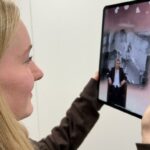Over the past five years, the rapid shift toward online shopping has reshaped the retail landscape. While e-commerce offers undeniable convenience, it also presents challenges, particularly for retailers, where tighter margins and rising fulfillment costs pose significant hurdles. In contrast, brick-and-mortar stores provide advantages such as lessening the costs of last-mile order fulfillment and encouraging higher consumer spending. However, what’s beneficial for retailers doesn’t always align with consumer preferences. To attract shoppers back to stores, retailers must offer them compelling reasons to visit. Augmented reality (AR) can provide one of them.
Establishing the Digital-to-Physical Bridge
To begin enticing online shoppers back into stores, retailers need to create a seamless connection between the digital and physical retail experiences. AR can act as that bridge by enhancing and mimicking key aspects of in-store shopping. Virtual try-on technology, for instance, allows users to visualize how apparel, accessories and makeup will look on them before ever setting foot in a store. This not only enhances engagement and boosts consumer confidence, but also reduces the rate of returns — a win-win for both shoppers and retailers.
From Home to Store: Creating an Experiential Journey
Virtual try-on can serve as the first step in an experiential journey that leads consumers from their homes to physical stores. However, technology alone isn’t enough. Shoppers need additional incentives to make the trip and forgo the convenience of online shopping.
In addition to the benefit of experiencing products in stores, AR offers unique ways to gamify the shopping experience and motivate in-store visits. Imagine a retailer offering exclusive digital collectibles through a mobile game, with in-store redemption as the only way to claim rewards. Once inside, shoppers could use AR-enabled mobile devices, similar to Pokémon Go, to locate and interact with their rewards, blending entertainment with commerce in an innovative way.
Incentivizing and Enhancing the In-Store Experience
Beyond driving in-store traffic, AR can elevate the in-store experience itself. Through AR-powered mobile interfaces, shoppers can access interactive promotions, discover unique experiences, and engage with branded content. This opens doors for potential partnerships. For example, department stores could collaborate with CPG companies or luxury brands to offer exclusive AR-driven promotions and collectibles.
Enhancing the in-store experience isn’t limited to promotional activities. There’s a functional component too. Virtual try-on can streamline the dressing room experience, allowing shoppers to visualize different sizes, colors or patterns without waiting in line. Meanwhile, AR-powered wayfinding, integrated with Internet of Things (IoT) sensors and micro-location, can help consumers navigate stores effortlessly, reducing frustration and freeing up employees to focus on higher-value tasks. Retailers can even incorporate digital brand ambassadors or spokespeople into AR wayfinding to create a more immersive and branded shopping experience.
The Future of Augmented Retail
The rise of e-commerce has reshaped the retail industry. Rather than replacing physical stores, it has paved the way for a new, blended ecosystem, one that seamlessly integrates digital innovation with in-person shopping. As consumers become increasingly comfortable with digital experiences, they’re more open to technologies like AR, which can transform stores into interactive, engaging spaces. The future of retail isn’t just about choosing between online and in-store; it’s about leveraging technology to create the best of both worlds.
Katie Riddle is the global retail strategy lead at Verizon Business.
Quelle:
Foto: Getty Images by Francesco Carta fotografo


